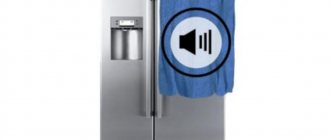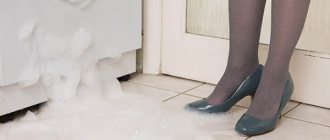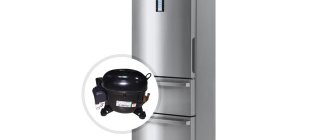A flood in the kitchen is usually the work of washing machines and dishwashers. However, sometimes it happens that the refrigerator can become a source of water. Is your assistant freezing as usual, but at the same time he “made a puddle”? So, our article is for you.
First, let's put aside the panic! Since the refrigerator is freezing, it means the problem is not that serious. It would be much worse if the puddle formed because the refrigerator stopped working altogether. Next, we proceed to a careful inspection of the refrigerator: you need to determine where the water is.
Reasons for the appearance of puddles under the refrigerator
Before taking any measures, you need to establish that the water under the refrigerator appeared precisely because of its breakdown. After all, it may be caused by factors not related to this technique. Perhaps the pipes, boiler or dishwasher are leaking. Or someone just spilled the water.
But it happens that these reasons are excluded, the puddle on the floor is wiped away, but after a while the water collects again. This means that the refrigerator is still leaking. If it freezes properly, there is no water inside, you need to figure out why a puddle may appear and what to do. Most often, you can cope with the problem yourself, but you need to take the advice of professionals.
Refrigerator leaking
Experts identify several reasons why water leaks from refrigerators:
- breakdown of the water container;
- problems with the drainage tube;
- the door does not close tightly.
Freezer doesn't close tightly
If the door is not closed tightly, warm air gets in. This causes the refrigerator to freeze more than usual. A layer of ice freezes on the walls. It thaws and moisture accumulates in the chamber. Excess water drains through the drainage tube and overfills the tank. Therefore, it leaks little by little regularly.
The simplest solution to this problem is to level the refrigerator by adjusting its legs. Or tighten the door hinges. After this, the door should close normally.
Shifting the drain pipe
A common reason why water leaks from under refrigerators is a problem with the drainage drain. This is a tube through which moisture is removed from inside the device. If the refrigerator is moved or used incorrectly, the tube moves and water may leak past the reservoir. The upper end of the tube may also come off; putting it back in place is more difficult, but still possible. You need to move the device away from the wall and put the drainage in place, fixing it in the correct position.
Important!
The tube must run smoothly and should not be bent.
If this is done, and the refrigerator is leaking, you need to carefully inspect the tube. Sometimes it breaks and water leaks through the cracks. In this case, you won’t be able to fix the problem yourself; you need to call a technician to replace the tube.
The water tank is broken
Often the refrigerator leaks from below due to a broken container for collecting water. This problem is easy to detect: it will be dry inside, and water appears only on the floor near the back wall. Moreover, depending on the degree of damage, it can leak a little or leak heavily. The crack can be sealed with a waterproof sealant, but this is a temporary solution. You will need to replace the tank; in some models you cannot do this yourself; it is better to call a specialist.
The water tank is broken
No power at the outlet
The simplest reason is lack of nutrition. There may be a power outage, a faulty socket, or a loose plug. Without power, the refrigerator turns off, the ice melts, liquid accumulates inside and flows.
Violation of the tightness of the refrigerator and freezer compartments
If the tightness of the refrigerator compartments is broken, water may also appear in the
refrigerator and under it. Such changes occur due to the entry of warm air into the limited cooled space. Most often, the problem is caused by the fit of the sealing material when it is damaged, the fastening part of the doors is distorted, or the position of the refrigerator is incorrect:
- Distortion of door hinges is corrected by adjustment. If it does not help, you need to consider other causes of leakage.
- A seal that has been damaged must be replaced with a new one. The procedure can be performed at a service center or independently.
- If the refrigerator is not positioned correctly, the door may also come off. To correct it, just adjust the legs until they are level. If there are no legs or there are not enough of them, you need to make a backing from a dense material.
If it is necessary to replace the sealing layer on the door of the refrigeration cabinet, you need to purchase this element in a special store. The sales consultant will clarify the necessary information and provide a suitable seal for the refrigerator model. Such items can also be provided during repairs at a service center.
Water under vegetable drawers
A small amount of moisture may appear inside the refrigerator on models with a drip defrosting system. Moreover, it flows down the back wall. If there is water under the vegetable drawer, this is not normal. But in many cases, the problem can be fixed on your own. Advice from professionals will help.
Why does water accumulate under the vegetable drawers in refrigerators?
- the drainage hole is clogged;
- The thermostat is broken;
- the compressor burned out;
- There was a freon leak.
Clogged drain hole in the refrigerator compartment
One of the reasons why refrigerators leak is due to obstruction of the drainage hole. During normal operation of the device, moisture flowing down the walls is collected into it. When it's clogged, water will leak down and pool under your fruit and vegetable drawers. The drain is usually clogged with crumbs, food particles or pieces of ice. There are several ways to clean it:
- use a cotton swab to remove the crumbs that have accumulated at the entrance;
- take a syringe and blow out the hole;
- Fill a syringe without a needle with warm water and inject it into it.
The best way to clean the drain is to flush it with warm water under pressure. Do not use knitting needles or other sharp objects for cleaning.
Important!
To avoid this problem, place food away from the walls and check the opening regularly.
Check the drain hole in the refrigerator
Water in the freezer
Water can also accumulate in the freezer compartment of a two-compartment refrigerator. This melts the ice due to the warm air that enters when the door is opened. This happens all the time, but the moisture should drain into the drainage hole. If it becomes clogged, liquid accumulates at the bottom. Water from the freezer may leak out and form a layer of ice around the door. This happens for several reasons:
- due to improper storage, food particles and crumbs get into the hole;
- if during defrosting it is difficult to rinse the freezer compartment;
- Increased water hardness leads to the accumulation of salt deposits.
Attention!
It is unlikely that you will be able to clean the drainage hole yourself; it is located deep, so it is better to call a professional.
Faulty thermostat
If water not only collects inside the refrigerator, but also flows onto the floor, the thermostat may be broken. It is responsible for the timely switching on and off of the compressor and maintaining the desired temperature in the chambers. Only a specialist can fix this breakdown, so you will have to contact a specialist. The refrigerator leaks for this reason if the engine is running constantly or it is too warm inside.
Sealing problems
Sometimes the cause of liquid appearing under the vegetable drawer or on the floor is the door seal. This strip of rubber is necessary to ensure the seal of the device when closed. With improper care or over time, the seal dries out, cracks, and therefore does not fit tightly. The only solution is to replace it. You can buy a rubber seal at any hardware store, and you can easily replace it yourself.
Check the seal on the refrigerator door
Freon leak
Water can accumulate in the refrigerator and leak out if there is a freon leak. This is the coolant that circulates through the tubes. If a crack occurs, cooling efficiency is reduced. Therefore, the refrigerator gradually defrosts. This also happens due to food crumbs getting into the cooling system. To prevent this problem from leading to equipment breakdown, you need to call a specialist.
Compressor burned out
The most serious breakdown that leads to leakage is a compressor malfunction. The problem can only be fixed at a service center.
Common causes of leaks and ways to solve the problem can be found in the table.
| Cause | Signs | How to fix |
| The drainage tube has come loose | Water only on the floor | Move the refrigerator, put the handset in place |
| Crack in the tube | Puddles on the floor | Replace handset |
| The water tank is broken | Puddles on the floor | Replace tank |
| The drain hole is clogged | There is a lot of moisture inside, ice, puddles on the floor | Clean or flush the hole |
| The door does not close tightly | Water inside and outside | Fix the refrigerator, adjust the hinges |
| The seal is broken | Liquid inside and outside | Replace seal |
Freon leak
Freon is an odorless cooling gas.
With the help of a compressor, it condenses into a liquid and then becomes a gas again, thus cooling the refrigerator. Therefore, it is clear that if freon leaks, the cooling process deteriorates sharply. There are several reasons for the malfunction:
- violation of welding seams due to sudden movement of the device;
- damage to tubes in the freezer when they try to scrape off ice with a knife;
- rusting of tubes when the refrigerator rarely defrosts;
- corrosion or defect.
Important! Signs of a freon leak may be the same as in the case of a damaged seal. To understand that a leak has occurred, you need to defrost and dry the refrigerator and inspect it later. If the grilles are cold at the back, the inside of the device is not cooled, and an oily puddle has accumulated near the compressor (which works evenly when it breaks down), then the freon has leaked out.
How to fix the problem? Be sure to call a specialist. He will determine the location of the leak using a special device, eliminate the fistula and refill the refrigerator.
Evaporator failure
Sometimes it happens that a refrigerator with a no frost system leaks. The peculiarity of this technique is that the resulting moisture settles on the evaporator, forming ice. It periodically heats up and water is discharged through a drainage tube into the tank.
Thanks to this, there is no humidity inside No Frost refrigerators. If water suddenly appears under such a device, the evaporator may be faulty. For example, the heating element or fan is broken. The evaporator does not remove the resulting moisture; it freezes on the inner walls and flows out. At the same time, there will be a lot of ice in the freezer and a puddle on the floor. Only a specialist can fix such a breakdown.
Evaporator failure
Problem prevention and general care tips
To avoid problems with refrigerator leakage, you need to carefully monitor each change in the operation of the refrigeration unit. The main indicators that need to be monitored are: the strength of the cold, streaks on the walls, frost and ice deposits. You should also apply techniques to prevent refrigerator malfunctions. To do this, you need to follow the simplest rules for storing food and caring for such equipment:
- The door must not be left open for long periods of time. To quickly find food, food needs to be put in a constant order.
- Products must be carefully wrapped before being placed in the compartments and wet items must not be placed. This will reduce the likelihood of clogged drain holes and the accumulation of excess condensate.
- Open containers with liquid products cannot be placed in the compartments of the unit - this leads to greater accumulation of condensate and its freezing to the walls and internal circuit.
- Experts advise covering the surface of the evaporator with cling film before placing food in the compartments. This reduces the likelihood of ice accumulation.
- Once every 3 months you can clean the internal surfaces and technological openings using a brush. Due to such cleaning, the nominal operating mode of the refrigeration unit is maintained.
- Cleaning the inside of the compartments and washing the walls should be done at least once a month. If the quantity stored is large enough, cleaning is carried out more often - once every 3 weeks.
- If the refrigerator is being prepared for transportation, use the original packaging or call the transportation service. This option will reduce the likelihood of damage to parts of the device.
- After putting things in order and washing the cameras, you need to wipe them thoroughly and leave the device open for 30 minutes. This approach will prevent moisture from flowing into the cracks of the housing and further damage by corrosion.
How to avoid such problems
To prevent water from accumulating in the refrigerator and leaking onto the floor, it must be used correctly. There are several recommendations for use:
- do not leave the door open, make sure it is sealed;
- food should be in containers so that crumbs do not fall into the drainage hole;
- do not place open containers with liquid inside, as it will evaporate;
- put only cold foods inside;
- When defrosting, do not use sharp objects to break off ice, as this may damage the freon tubes;
- do not touch the door seal when opening, periodically treat it with silicone grease;
- monitor the cleanliness of the internal chambers.
If water appears in the refrigerator or on the floor next to it, you need to determine the cause as soon as possible. It is recommended to defrost the equipment and find the problem. In the event that it is impossible to fix the problem yourself, be sure to call a specialist. If this is not done in time, it will lead to more serious damage to the device.
Internal leak
As you already know, condensation accumulates on the back wall of the chamber and then flows through the drainage hole into the evaporator. This hole may simply become clogged, and then water will not be able to pass through it. Consequently, the container itself for collecting condensate will be empty, and there will simply be nothing to evaporate from there.
If this hole becomes clogged (a parsley leaf can get there, for example), then water will flow into the chamber itself. As a result, there will be a puddle at the very bottom of the refrigerator compartment, which over time will become so large that it will simply overflow.
What to do in this case? First of all, you need to find a drainage hole - look for it on the back wall (all food must first be removed). Found it? Look visually to see if anything is preventing the free flow of water to it? If there is any obstacle, it must be removed. If everything is clean, then there is a possibility of internal blockage. This means that the entire tube must be cleaned. This can be done using water pressure. You can simply pour water from the kettle into it and see if it flows out into the condensate container at the back. Such a flow can move a blockage that the condensate could not move. Still, it flows into the pan in small drops, and not with a powerful pressure.
If you cannot break through the blockage using a stream of water, you can try to remove it using a long wire. Most often this helps solve this problem.











